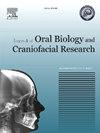Role of salivary Insulin-like Growth Factor-1 (IGF-1) in the regulation of biomechanical process following mandibular advancement with a twin block appliance-a prospective observational study
Q1 Medicine
Journal of oral biology and craniofacial research
Pub Date : 2025-05-23
DOI:10.1016/j.jobcr.2025.05.004
引用次数: 0
Abstract
Background
An increased expression of Insulin-like growth factor-1 (IGF-1) in the condyle following mandibular advancement has been observed in animal studies. However, the exact role of IGF-1 in the regulation of biomechanical process of Twin block in humans is still unclear. Hence, the aim of the present study was to investigate the role of salivary IGF-1 following mandibular advancement with Twin block appliance in subjects having skeletal Class II malocclusion.
Materials and methods
This prospective observational study enrolled 49 subjects with skeletal Class II malocclusion who were administered Twin block. Salivary samples were collected at: pre-treatment (T0), one week (T1), 6–10 weeks (T2), 8–10 months (T3) and post-treatment (T4). Subjects who were non-compliant were taken as the non-compliant group (NCG; n = 10), (Twin block group, TBG; n = 39). Lateral cephalograms were obtained at T0, T3 and T4 for TBG and at T0, T4 for NCG to evaluate the various skeletal and dentoalveolar effects. Friedman test, Wilcoxon signed test and Mann-Whitney U test were performed for statistical comparison of salivary IGF-1 levels and cephalometric parameters within and between the two groups.
Results
In TBG, salivary IGF-1 levels significantly increased at one week (p = 0.000), followed by a plateau, while NCG showed no significant changes. Cephalometric analysis revealed significant improvements in mandibular length and other parameters in TBG compared to NCG.
Conclusions
The study demonstrates a significant increase in salivary IGF-1 levels following mandibular advancement, suggesting its regulatory role in biomechanical process of the Twin block appliance.
Clinical relevance
The findings of this study hold significant future potential in the field of dentofacial orthopaedics. The development of a panel of salivary biomarkers could offer a more comprehensive understanding of the biological processes involved in mandibular advancement and growth, leading to more precise and customized treatment plans.
唾液胰岛素样生长因子-1 (IGF-1)在双块矫治器下颌前移后生物力学过程中的调节作用-一项前瞻性观察研究
在动物实验中已经观察到,随着下颌骨的发展,髁突中胰岛素样生长因子-1 (IGF-1)的表达增加。然而,IGF-1在调节人类Twin block生物力学过程中的确切作用尚不清楚。因此,本研究的目的是探讨在患有骨骼II类错颌畸形的受试者中,使用双块矫治器下颌前移后唾液IGF-1的作用。材料和方法本前瞻性观察性研究纳入49例骨骼II类错颌畸形患者,给予Twin block治疗。分别于治疗前(T0)、1周(T1)、6-10周(T2)、8-10个月(T3)和治疗后(T4)采集唾液样本。不服从者作为不服从组(NCG;n = 10),(双块组,TBG;n = 39)。TBG和NCG分别在T0、T3、T4和T0、T4进行侧位脑电图,以评估骨骼和牙槽牙的各种影响。采用Friedman检验、Wilcoxon sign检验和Mann-Whitney U检验对两组患者的唾液IGF-1水平和头颅测量参数进行统计学比较。结果TBG组唾液IGF-1水平在第1周显著升高(p = 0.000),随后进入平台期,NCG组无显著变化。头颅测量分析显示,与NCG相比,TBG的下颌长度和其他参数有显著改善。结论研究表明,下颌骨前移后唾液IGF-1水平显著升高,提示其在Twin block矫治器生物力学过程中起调节作用。本研究结果在牙面矫形领域具有重要的未来潜力。开发一组唾液生物标志物可以更全面地了解下颌骨发育和生长的生物学过程,从而制定更精确和定制的治疗计划。
本文章由计算机程序翻译,如有差异,请以英文原文为准。
求助全文
约1分钟内获得全文
求助全文
来源期刊

Journal of oral biology and craniofacial research
Medicine-Otorhinolaryngology
CiteScore
4.90
自引率
0.00%
发文量
133
审稿时长
167 days
期刊介绍:
Journal of Oral Biology and Craniofacial Research (JOBCR)is the official journal of the Craniofacial Research Foundation (CRF). The journal aims to provide a common platform for both clinical and translational research and to promote interdisciplinary sciences in craniofacial region. JOBCR publishes content that includes diseases, injuries and defects in the head, neck, face, jaws and the hard and soft tissues of the mouth and jaws and face region; diagnosis and medical management of diseases specific to the orofacial tissues and of oral manifestations of systemic diseases; studies on identifying populations at risk of oral disease or in need of specific care, and comparing regional, environmental, social, and access similarities and differences in dental care between populations; diseases of the mouth and related structures like salivary glands, temporomandibular joints, facial muscles and perioral skin; biomedical engineering, tissue engineering and stem cells. The journal publishes reviews, commentaries, peer-reviewed original research articles, short communication, and case reports.
 求助内容:
求助内容: 应助结果提醒方式:
应助结果提醒方式:


